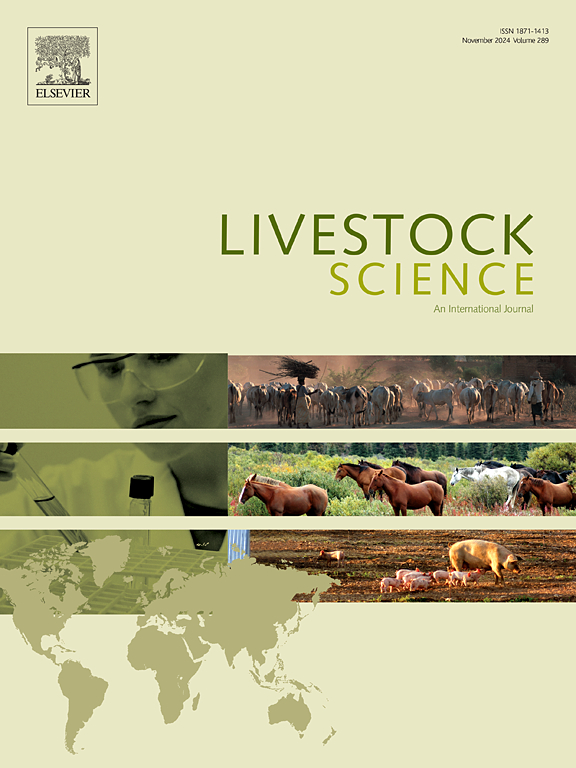饲喂含snaplage日粮的Nellore公牛牛肉品质及脂质代谢相关基因的表达
IF 1.9
3区 农林科学
Q2 AGRICULTURE, DAIRY & ANIMAL SCIENCE
引用次数: 0
摘要
本研究的目的是通过化学成分、颜色、剪切力以及脂质代谢相关基因的表达来分析Nellore公牛饲喂snplage后肌肉的品质。选用72头初始活重为400±27.4 kg的内洛尔公牛,采用完全随机设计。公牛被安置在8个围栏中,每个围栏3只,围栏被视为实验单位。试验饲粮为对照饲粮、snapplage +玉米粉(SNAP65, snapplage含量65%)和snapplage (SNAP85, snapplage含量85%)。经过86天的实验,这些动物通过震荡休克和切断颈静脉进行屠宰。剥皮后,从左半胴体取胸最长肌(LT)肌肉样本。采用RT-qPCR技术分析基因表达。LT肌的化学成分不受饮食中是否含钠的影响(P >;0.05)。而饲喂SNAP85的动物PPARG表达较高(P = 0.03)。饲喂SNAP65和SNAP85的公牛肌肉中ACACA和SCD1基因的表达量高于对照组(P≤0.03)。对照组动物肝脏中PC的表达高于SNAP65和SNAP85,而PEPCK2在对照组和SNAP85处理动物中的表达高于SNAP65处理动物。我们得出的结论是,添加青贮饲料可以取代其他类型的饲料和青贮饲料,因为它们增加了参与脂肪生成的基因的表达,并且不影响牛肉的定性属性。本文章由计算机程序翻译,如有差异,请以英文原文为准。
Beef quality and expression of genes involved in lipid metabolism in Nellore bulls finished with diets containing snaplage
The objective of this study was to analyze beef quality through chemical composition, color, and shear force, as well as the expression of genes involved in lipid metabolism, in the muscle of Nellore bulls fed snaplage. Seventy-two Nellore bulls with an initial live weight of 400 ± 27.4 kg were used in a completely randomized design. Bulls were housed in 8 pens per treatment with three animals each, with pens considered the experimental units. The experimental diets were control, snaplage + ground corn (SNAP65, with 65% snaplage), and snaplage (SNAP85, with 85% snaplage). After an experimental period of 86 days, the animals were slaughtered by concussion stunning and severing of the jugular vein. After skinning, longissimus thoracis (LT) muscle samples were taken from the left half-carcass. Gene expressions were analyzed using the RT-qPCR technique. The chemical composition of the LT muscle was not influenced by the inclusion or absence of snaplage in the diet (P > 0.05). However, animals fed SNAP85 showed higher PPARG expression (P = 0.03). The muscle of young bulls fed SNAP65 and SNAP85 showed higher expression of the ACACA and SCD1 genes (P ≤ 0.03) than the control muscle. PC expression in the liver was higher for the control treatment than SNAP65 and SNAP85, while PEPCK2 had greater expression in animals fed control and SNAP85 treatments than in those fed SNAP65. We conclude that diets with snaplage can replace other types of diets and silages since they increase the expression of genes involved in lipogenesis and do not affect qualitative beef attributes.
求助全文
通过发布文献求助,成功后即可免费获取论文全文。
去求助
来源期刊

Livestock Science
农林科学-奶制品与动物科学
CiteScore
4.30
自引率
5.60%
发文量
237
审稿时长
3 months
期刊介绍:
Livestock Science promotes the sound development of the livestock sector by publishing original, peer-reviewed research and review articles covering all aspects of this broad field. The journal welcomes submissions on the avant-garde areas of animal genetics, breeding, growth, reproduction, nutrition, physiology, and behaviour in addition to genetic resources, welfare, ethics, health, management and production systems. The high-quality content of this journal reflects the truly international nature of this broad area of research.
 求助内容:
求助内容: 应助结果提醒方式:
应助结果提醒方式:


